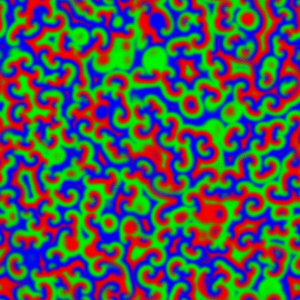A softer, gentler robot controlled by light
May 6, 2015

Robotic material made from SP-BZ gel changes form in non-uniform light (credit: Olga Kuksenok & Anna C. Balazs/Scientific Reports)
A bio-inspired prototype “soft robot” material with greater dexterity and mobility than conventional hard robots has been created by researchers at the University of Pittsburgh’s Swanson School of Engineering.
“In biology, directed movement involves some form of shape changes, such as the expansion and contraction of muscles,” said Anna C. Balazs, PhD, the Swanson School’s Distinguished Professor of Chemical and Petroleum Engineering. “So we asked whether we could mimic these basic interconnected functions in a synthetic system so that it could simultaneously change its shape and move.”

Computer simulation of the Belousov–Zhabotinsky reaction occurring in a Petri dish (credit: Wikimedia Commons)
To do that, the researchers used the simple single-celled organism euglena, which expands and contracts its shape to move, as a model. To mimic the euglena’s mobility, they chose polymer gels containing spirobenzopyran (SP), which can be easily morphed into different shapes with the use of light, and Belousov-Zhabotinsky (BZ) gels, which exhibit self-organizing periodic pulsations when triggered by light.
The combination “SP-BZ” gels undergo agile self-bending and self-propelled changes in presence of light, caused by internally generated chemical energy.
Their open-access research was published April 30th in the journal Scientific Reports, published by Nature
Abstract of Designing Dual-functionalized Gels for Self-reconfiguration and Autonomous Motion
Human motion is enabled by the concerted expansion and contraction of interconnected muscles that are powered by inherent biochemical reactions. One of the challenges in the field of biomimicry is eliciting this form of motion from purely synthetic materials, which typically do not generate internalized reactions to drive mechanical action. Moreover, for practical applications, this bio-inspired motion must be readily controllable. Herein, we develop a computational model to design a new class of polymer gels where structural reconfigurations and internalized reactions are intimately linked to produce autonomous motion, which can be directed with light. These gels contain both spirobenzopyran (SP) chromophores and the ruthenium catalysts that drive the oscillatory Belousov-Zhabotinsky (BZ) reaction. Importantly, both the SP moieties and the BZ reaction are photosensitive. When these dual-functionalized gels are exposed to non-uniform illumination, the localized contraction of the gel (due to the SP moieties) in the presence of traveling chemical waves (due to the BZ reaction) leads to new forms of spontaneous, self-sustained movement, which cannot be achieved by either of the mono-functionalized networks.